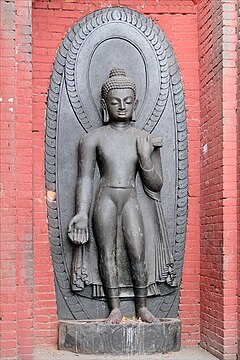This article needs additional citations for verification. (September 2007) |
| Dipankara Buddha | |
|---|---|
 7th century statue in a niche of Swayambhunath, Kathmandu
The great stupa is surrounded by numerous monuments, secondary stupas and religious sculptures. | |
| Sanskrit | Dīpaṃkara |
| Pāli | Dīpaṅkara |
| Burmese | ဒီပင်္ကရာ ([dìpɪ̀ɰ̃kəɹà]) |
| Chinese | 燃燈佛 (Pinyin: Rándēng Fó) |
| Japanese | 燃燈仏 (romaji: Nentō Bosatsu) |
| Khmer | ព្រះពុទ្ធ ទីបង្ករៈ "Preah Puth Dipankara" |
| Korean | 연등불 (RR: Yeondeung Bul) |
| Mongolian | ᠵᠣᠯᠠ ᠢᠢᠨ ᠵᠥᠬᠢᠶᠠᠭᠴᠢ᠂ ᠳᠢᠸᠠᠩ᠋ᠭᠠᠷ; Зулын Зохиогч, Дивангар; Zula yin Zohiyagci, Divangar |
| Sinhala | දීපඞ්කර බුදුන් වහන්සේ Dipankara Budun Wahanse |
| Thai | พระทีปังกรพุทธเจ้า Phra Thipangkon Phutthachao |
| Tibetan | མར་མེ་མཛད་ Wylie: mar me mdzad THL: Marmedzé |
| Vietnamese | Nhiên Đăng Phật |
| Information | |
| Venerated by | Theravada, Mahayana, Vajrayana |
| Attributes | Causer of Light [citation needed] |
Dipankara (Pali: Dīpaṅkara; Sanskrit: Dīpaṃkara, "Lamp bearer") or Dipankara Buddha is one of the Buddhas of the past. He is said to have lived on Earth four asankheyyas and one hundred thousand kappas ago.[1] According to some Buddhist or folk traditions, Dipankara was a previous Buddha who attained Enlightenment eons prior to Gautama Buddha, the historical Buddha.
Generally, Buddhists believe that there has been a succession of many Buddhas in the distant past and that many more will appear in the future. Dipankara was one of these previous Buddhas, while Gautama Buddha was the current and most recent Enlightened one, and Maitreya will be the next Buddha in the distant future.
Chinese Buddhism honors Dipankara as one of many Buddhas of the past. Dipankara, Gautama, and Maitreya are "the Buddhas of Three Times" in Yiguandao.
- ^ World Cycles When Buddhas Appear (PDF). p. 117.